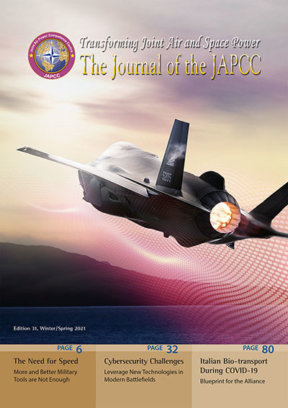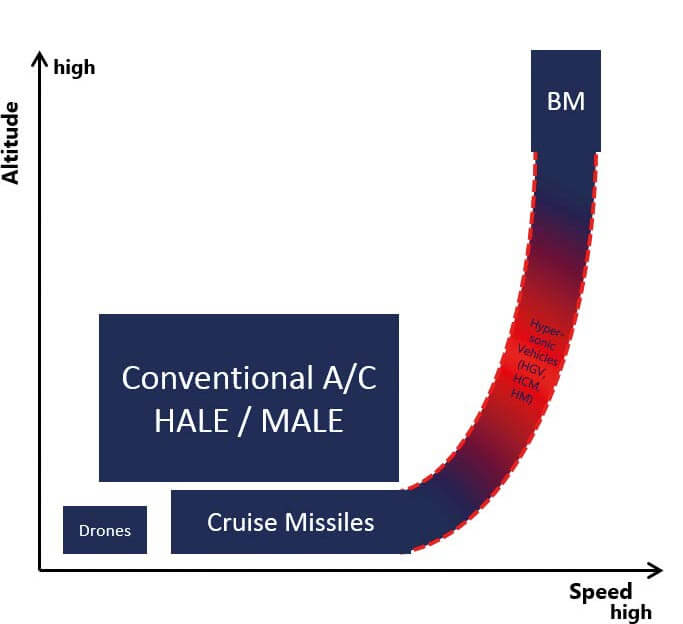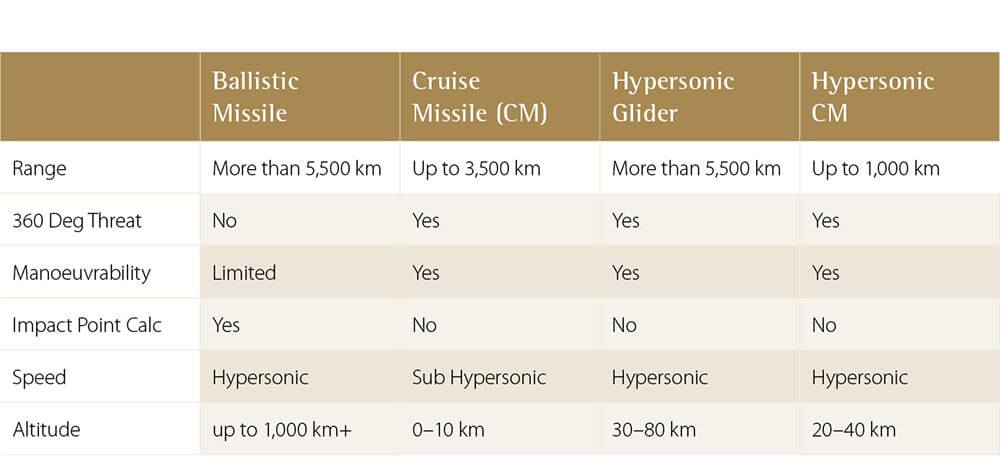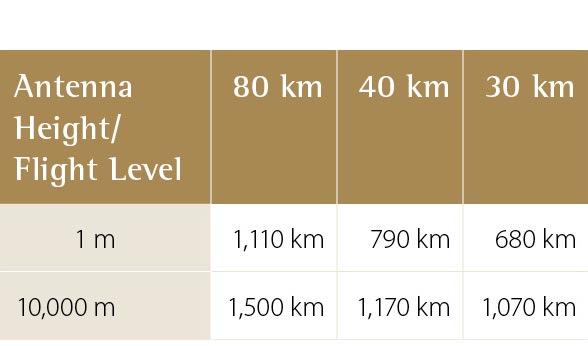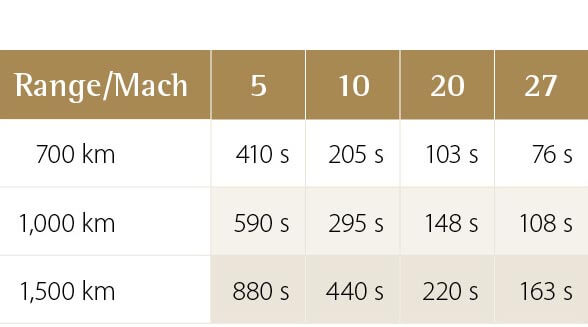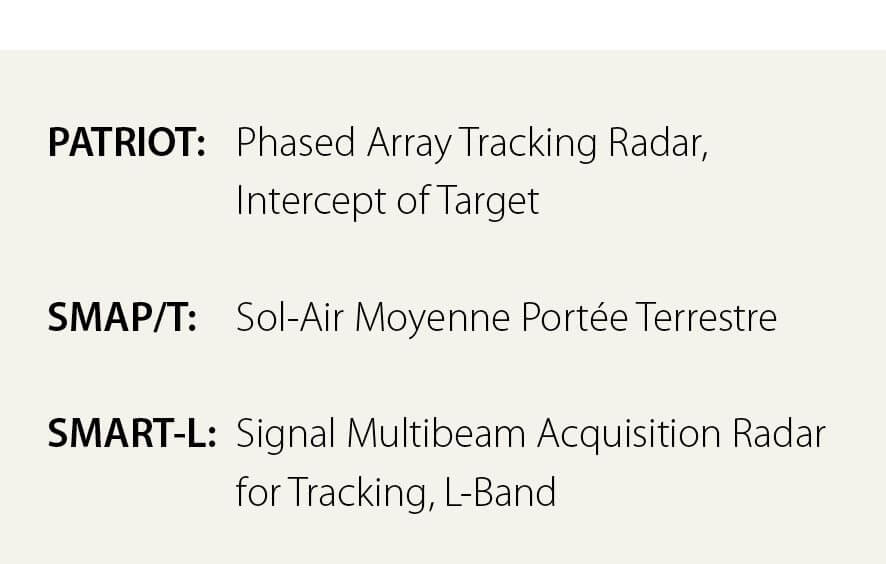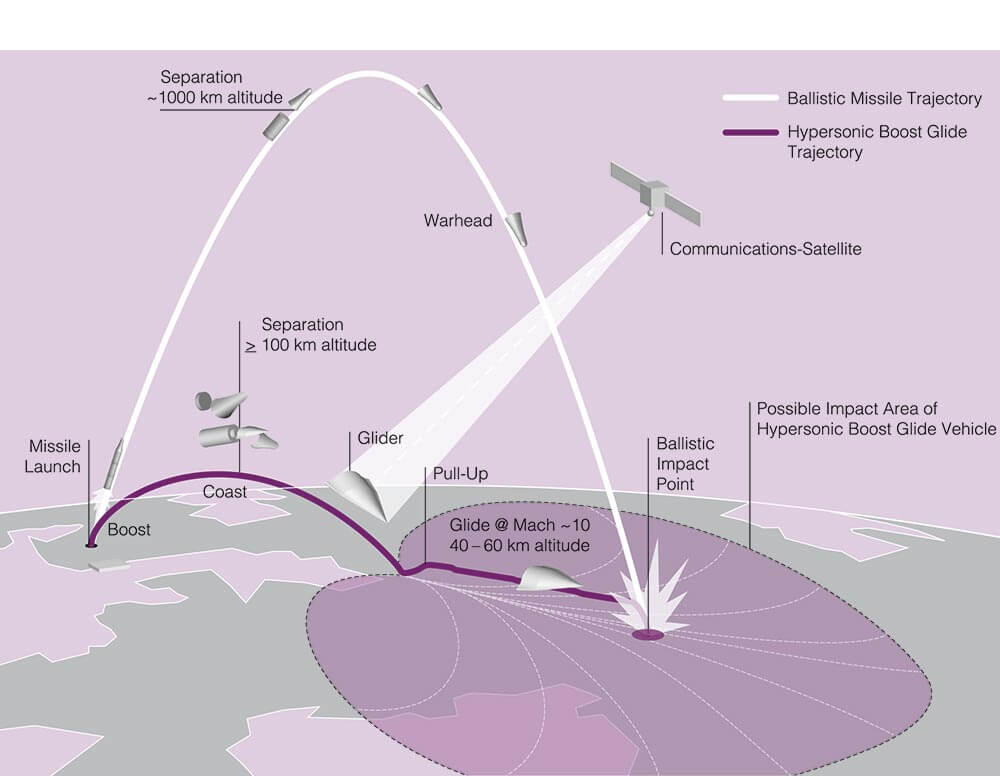Introduction
It is almost impossible to read current literature about NATO‘s threat spectrum without having Hypersonic Operational Threats (HOT) mentioned as an emerging ‘game-changer.’ The following article is based on a Specialist Team Report of NATO’s Science and Technology Organization about Hypersonic Threats1 and will analyse the impact hypersonic threats may have on NATO’s defensive posture, what kind of gaps might be created, and what NATO might have to do to mitigate these vulnerabilities.
Threats like Hypersonic Glide Vehicles (HGV) or Hypersonic Cruise Missiles (HCM) are not a completely new threat category, since they bear certain similarities to ballistic missiles or ’old fashioned’ sub-hypersonic cruise missiles. Hence, it seems reasonable to base the analysis on available capabilities against these existing threats.
However, HOT are a significant challenge for NATO’s current defensive capabilities. Extensive studies are necessary to gain a sufficient understanding of the severity of the situation and the resulting necessary steps to maintain a stable security environment for NATO.
NATO’s Current Deterrence Framework
NATO‘s capability to successfully deter potential adversaries is based on a credible combination of offensive (including both nuclear and conventional) and defensive options. Therefore, these options cannot be looked at in isolation, but rather must be evaluated in a comprehensive manner. Collective Defence is one key element of NATO’s overall deterrence strategy. In order to gain a military advantage, it can be expected that potential adversaries will develop capabilities to undermine NATO’s current capability set (e.g. NATO Integrated Air and Missile Defence System (NATINAMDS)), which will automatically weaken the credibility of NATO’s deterrence. This necessitates an adaptive posture and likely new capabilities on the Alliance’s side, such as NATO Ballistic Missile Defence (BMD) or the NATO Very High Readiness Joint Task Force (VJTF) in the past. From this perspective, the emergence of HOT is a logical reaction from potential adversaries towards the current defensive and offensive capabilities of NATO.
Hypersonic Capabilities as a Threat
A military threat, being the combination of capability and intent, is generally anticipated to create a particular effect, geared towards generating a tactical, operational or strategic advantage over an opponent. In contrast, every defensive measure is conceptualized to cover a specific threat or threat spectrum. In the framework of air threats, key parameters like speed, reach, and height2 have significant importance, as can be seen in Figure 1 below.
Figure 1: Threat Model.
Historically, the most common air threats were regular aircraft. Over recent decades, this threat portfolio broadened with the addition of ballistic and cruise missiles and unmanned aerial vehicles, to which NATO always found an answer for maintaining a deterrent balance, for instance NATO BMD for ballistic missiles. HOT represent an area not covered, or only marginally so, by NATO’s current defensive capabilities; this should energize NATO to take its next adaptive step to mitigate this challenge.
Definition of Hypersonic Operational Threats
Despite the lack of an unambiguous definition for hypersonic speeds, for this paper and in most military contexts, a speed greater than Mach 5.0 will be assumed. This causes a severely reduced timeframe for implementing a potential kill chain. Furthermore, the altitude bands used by HOT, combined with significant manoeuvrability at these high speeds, create further complications for available sensors and interceptors. In comparison to a ballistic missile threat, HOT flight paths and impact points are very unpredictable. Generally, two classes of HOT can be identified: HGVs or HCMs. For both systems, it has to be assumed that they have precision strike capabilities which are supported by on-board sensors.
Hypersonic Glide Vehicles
HGVs are non-powered manoeuvrable vehicles that are boosted by and later separated from, a carrier system, for the attack of land or sea targets. The carrier system, normally rocket boosters, must be capable of creating the initial speed for the HGV to perform hypersonic gliding manoeuvres. After re-entry, they can cover additional large distances by flying glide or phugoid trajectories. After an initial, rather depressed ballistic trajectory, HGVs have an average gliding altitude between 30 and 80 km. During the final phase, which can be gradual or very steep, their speeds should be reduced to high supersonic levels. These systems consist of a launch device and at least one glide vehicle. Options for ground, sea or air-launch are conceivable.
Figure 2: Parallels to Existing Threats.
Hypersonic Cruise Missiles
HCMs are powered air-breathing vehicles characterized by sustained hypersonic flight for the majority of their trajectory. They rely upon aerodynamic forces for lift and are used to attack land or sea targets. Generally, they travel at altitudes of between 20 and 40 km to maintain their hypersonic cruise speeds ranging between Mach 5 and Mach 7 (higher speeds are possible.) For the attack phase, they might either perform a steep dive manoeuvre or enter a traditional low flight profile phase; in both cases slowing down to speeds of approximately Mach 3.
Bridging Capabilities
Other threats with hypersonic speeds, like the Russian Kinzhal or other ballistic missiles with very depressed flight paths, might have attributes of an HGV, but are not considered as a HOT. However, this shows that the modernization of existing threats (e.g. SS-26 Iskander) can bridge the gap between classical threats and HOT. Therefore, HOT should not be looked at in isolation.
Parallels to Existing Threats
From a defensive perspective, and based on the manoeuvrability and range, there are parallels between HOT and conventional cruise missiles. In both cases, it is nearly impossible to get an early impact point prediction, and it poses a 360° threat for critical assets. Should NATO possess an operational HOT defence system, the defence design would most likely have to follow the principles used for cruise missile defence. However, NATO does not have such a system nor enough resources to employ a comprehensive cruise missile defence for all NATO territory today. Currently, only specially identified objects and limited areas can be defended against cruise missile threats.
Potential Limitations of Current NATO Air Defence Systems
The effectiveness of Air and Missile Defence (AMD) systems is determined by the capabilities of their sensors and interceptors. NATO’s current portfolio spans numerous systems that cover various threat categories, but do not include any systems (due to technical feasibility or monetary reasons) that can cover all threat categories in all altitude bands.
This does not mean that NATO nations do not already possess very potent space-based, airborne or surface-based sensors. Still, they need to evaluate which sensors qualify for the detection and tracking of HOT, and which sensors can provide fire solutions. It can be surmised that modern, often software-steered sensors can be adapted, but how this affects overall functionality and performance still needs to be evaluated. Also, adequate data fusion of all available sensors needs to be in place or enabled to cope with these future threats.
The area in which AMD interceptors can deliver their effect is called ‘battlespace,’ which is mainly limited by the interceptor’s propulsion and manoeuvrability. The significantly elevated threat requirements of HOT increase the likelihood of them taking flight paths outside of the current interceptors´ battlespaces.
With the currently available interceptors, it is likely that an intercept has to occur in the final phase of the flight path. This limits tremendously the distance by which an interceptor can be separated from a protected asset and reduces the opportunity for a second shot at the threat.
Although current Command and Control (C2) structures and data link capabilities are potent and agile enough to handle the present threat set, how they may need to be adapted to also cover HOT has yet to be evaluated.
Use-Case Options for HOT
Currently, three adversary use-cases seem plausible for HOT:
- Due to the increased likelihood of delivering the intended effect, HOT are likely to be used as a tool for strategic or immediate tactical/operational effects. Currently, peer opponents do not gain many additional benefits by employing HOT against NATO European territory, since the same effect can be achieved by existing and less expensive means. Against the United States of America (USA), however, HOT create options for avoiding missile defence systems like the Ground-Based Midcourse Defence system or to threaten high-value assets like aircraft carriers or critical infrastructure. Nevertheless, due to the very high chance of effect delivery by HOT, independent of employed defensive means, the opponent’s calculation of necessary offensive means becomes more predictable, the strategic communications messaging more straightforward, and places additional stressors on NATO’s defence design decisions. For near-peer or non-peer opponents, HOT represent a real gain in capabilities, since they have no other means to overcome NATO’s AMD systems. Therefore, HOT, in this case, may be a credible means of coercion, to promote political interests, and for steering escalation/de-escalation of a conflict.
- For an ’escalate-to-deescalate’ strategy by peer opponents, HOT seem to be an effective tool, since even a single weapon can reliably produce a strategic effect. Also, HOT could support a credible second-strike capability for peer opponents.
- HOT can be employed as a force enabler and multiplier, by aiming at critical elements of NATO IAMD or other critical military components to allow more numerous offensive weapons to be employed effectively. For peer opponents, this is currently only a quantitative benefit, since the same effect could be reached by saturation. Still, for near- or non-peer opponents this is a significant qualitative benefit.
How Can a Capability Gap be Mitigated?
As with the adversary use-cases, there is a distinction between peer and non-peer opponents as well as peacetime and conflict scenarios. Since HOT influence both of NATO’s pillars of deterrence (nuclear deterrence and collective defence), compensatory measures should ensure that the sum of both pillars still provides credible deterrence.
For peer opponents in peacetime against NATO Europe, HOT will not be able to deliver extra effects and therefore do not drive a need to react. Existing credible means of deterrence should continue to be employed. However, the compressed decision timelines, especially in the transition to conflict window, need to be reflected in NATO’s C2 structure and processes. Should deterrence fail, and conflict becomes likely, a qualitative and quantitative overmatch for available AMD systems can be assumed. In such a scenario, NATO should concentrate on the defence of critical and high-value assets.
Since no potential non-peer opponents possess HOT, NATO should concentrate on the non-proliferation of HOT systems, materials and knowledge. Should these measures fail, NATO should raise the severity of consequences for opponents to employ HOT, to maintain credible deterrence. The development of counter-HOT systems will take several years, and NATO-wide protection is not only technically, but economically complex. Therefore, the capability gap must first be offset by harsher consequences through credible offensive measures to reduce the perceived benefits to a potential adversary of using HOT. Should deterrence still fail, NATO must evolve its collective defence capabilities so that they can be effectively employed in a conflict including HOT. A combination of defensive, offensive and passive defence measures, supported by a suitable Battle Management, Command, Control, Communications and Intelligence (BMC3I) system, needs to be identified, to significantly reduce the added value of employing HOT by the opponent.
What is Needed to Close the Capability Delta?
As a first step, NATO needs to assess HOT realistically, including our current capabilities to counter HOT, and ensure that the policy/doctrine basis is fit for their optimal employment and that these are suitable for new capabilities to be seamlessly integrated. NATO must strategically state that initial weaknesses in collective defence are compensated (in short- to mid-term) by other measures of credible deterrence. It seems plausible that this will necessitate a multi-domain approach, which needs to be reflected in an adequate C2 structure, appropriate rules of engagement, and is represented in NATO and national education and training processes at all military and political levels.
System Requirements for HOT Defence
A comprehensive answer covering system requirements for an effective solution to HOT requires an assessment of all four pillars of NATO Integrated Air and Missile Defence (Active Air Defence, Passive Air Defence, Surveillance and BMC3I) and all steps of the kill chain. Point and area defence plans or schemes of assets must both be assessed.
It would be beneficial to have sufficient sensor capabilities to gain and maintain a continuous track of a HOT from launch to intercept or impact. Due to the relatively low altitude compared to ballistic missiles (HGVs 30-80 km, HCMs 20-40 km), this is hard to achieve. Because of the earth’s curvature and anticipated flight levels, detection ranges are limited.
Therefore, the initial focus should be on the necessary sensor network for early warning (both military and civilian) and engagement; hence the boost phase and the phase before intercept, currently most likely the final phase. These ranges lead, in combination with the target speed, to corresponding early warning times.
For more accurate and better early warning and cueing of other sensors, space-based sensors in various orbits (e.g. geostationary, low earth orbit) may be beneficial. Detailed requirements for coverage and robustness, especially against peer opponents, must be identified.
Outside of simulation environments, HOT are not available for testing against current AMD weapons systems. This makes solid intelligence data necessary, not only for future defence planning, but also for defining general system requirements. It cannot be stated with high confidence that sensors currently available (e.g. PATRIOT, SAMP/T, SMART-L) are capable of detecting and tracking manoeuvring HOT. Although these systems may be adapted using software fixes, the consequences for the remaining task load (e.g. tracking aircraft or ballistic missiles) must also be identified. Existing early warning systems like the US Shared Early Warning (SEW) system, which uses infrared sensors to detect missiles in their boost phase, should be capable of detecting HGVs and likely HCMs since their boosters have a significant boost phase. The need for further land-, sea-, air- or space-based sensors must be analysed to guarantee successful defensive engagement options against HOT.
Radar sensors seem suitable to produce fire-control solutions for HOT, and point defence should be possible, assuming the availability of suitable sensors and effectors. For a comprehensive area defence, a very large number of sensors is required, especially when considering the need for a robust array of sensors and the required communications architecture. This also necessitates a very robust network and seamless integration into NATINAMDS. Given these networked capabilities, the remote engagement options3 should be made available to support optimized sensor-effector usage.
Figure 3: Hypersonic Vehicles and Ballistic Missiles in Comparison. © DLR
In general, an interceptor needs to be capable of reaching an intercept point with its intended target, and it needs to have an appropriate warhead to deliver a sufficient effect on the target. For HOT, this means that interceptors need to reach altitude bands between 20 and 80 km. Also, the interceptor needs to have extended range at high speed, and very high agility to be useful against manoeuvring HOT. Specific parameters for different HOT must be analysed and identified. Options for other than ground-based interceptors should be assessed as well.
Furthermore, the effects on target need to be sufficient to deny the primary mission of the HOT and to minimize collateral damage, such as debris or remaining Weapons of Mass Destruction (WMD). Based on BMD experience, hit-to-kill technology can achieve such effects. Alternatively, interceptors with fragmentation warheads could be effective due to the high speeds, high temperatures and importance of structural integrity of a HOT. Even minor amounts of damage caused by small fragments might be sufficient to cause fatal structural damage. Overall, it has to be analysed, which kind of interceptor is preferable for engaging HOT targets. Directed energy solutions appear to be less promising since HOT are designed to withstand high temperatures by nature. Electronic Warfare such as jamming and spoofing of HOT seems to be very difficult due to the high speed and non-predictability of offensive systems.
On the assumption that a HOT interceptor is available, appropriate fire doctrines need to be determined. This could be supported by ideas from swarm technology or artificial intelligence. Also, a higher level of interceptor autonomy might be useful, but a legal framework to employ such systems must be developed and agreed upon before use.
Conclusion
In the light of Russia’s claim that their HGVs have been operationally available since December 2019 and western scientists’ assessments that the development of HOT is progressing well, it is reasonable to assume that HOT will be appearing on the battlefield within the next 5–10 years; hence the imminence of the threat is very credible. Considering procurement timelines for advanced weapon systems such as HOT defence systems or the time it might take to adapt existing AMD systems, NATO will have a capability gap against HOT for some time. A decision must be made as soon as possible on how to mitigate this gap. The potential deficit in credible deterrence must be offset by a balanced mix of defensive measures and credible measures of ‘deterrence by punishment’. Considering that NATO has no comprehensive area defence against regular cruise missiles for various reasons, it will be even more challenging to achieve this for HOT.
Hence, the initial focus for HOT defence should be point defence of identified critical military or civilian assets. As a second step, the necessity and feasibility of area defence needs to be looked at and possibly implemented. Overall, NATO must ensure that the required framework for credible deterrence of adversaries with HOT remains intact.

